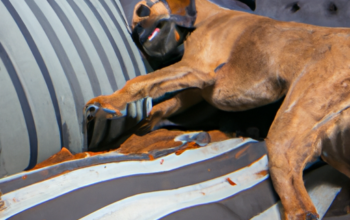Have you ever wondered how dogs age or why some breeds live longer than others? Understanding the aging process of our canine companions isn’t as straightforward as the widely accepted ‘seven-year rule’. It’s a complex process influenced by several factors including breed, lifestyle, and general health.
This article will debunk the common misconception of equating seven human years to one dog year. We’ll explore how various factors affect your furry friend’s lifespan and delve into specific breed longevity. You’ll gain insight into the role genetics play in canine aging, along with significant lifestyle impacts on their overall life expectancy.
By understanding how your pet ages, you can better cater to their evolving needs and ensure they live a long, healthy life. Prepare to dive deep into the fascinating world of canine aging; it’s more intricate than you might think!
Debunking the ‘Seven-Year Rule’
You’ve probably heard the old saying that one human year equals seven dog years, but this ‘seven-year rule’ isn’t as accurate as you might think. This is one of those age calculation myths that has been passed down through generations.
The truth is, canine aging doesn’t follow a simple formula. Instead, it’s influenced by factors such as breed and size. Canine growth stages play a crucial role too; dogs mature more quickly during their first two years than in later life.
For instance, a one-year-old small breed dog may be about 15 in human years while large breeds could be closer to 14.
So next time you’re calculating your pooch’s age, remember: the ‘seven-year rule’ is more folklore than fact. Understanding canine growth stages will give you a more accurate picture.
Factors Influencing Canine Lifespan
Just as a tree’s lifespan is influenced by its environment and care, so too are our furry friends’ years determined by various factors like breed, size, genetics, diet, and exercise regimen. These elements can significantly affect a dog’s life expectancy.
-
Breed: Certain breeds naturally have longer lifespans than others.
-
Size: Generally, smaller dogs live longer than larger ones.
-
Genetic Determinants: Some genetic traits inherited from parents can impact your pup’s longevity positively or negatively.
-
Nutritional Influence: A balanced diet plays an integral part in your dog’s health and longevity.
-
Exercise Regimen: Regular physical activities help to maintain weight and overall health.
Understanding these influences allows you to provide the best care for your canine companion, potentially extending their lifespan.
The Role of Breed in Aging
Ever wondered why your tiny Chihuahua seems to have more birthdays than your massive Great Dane? It’s all about the genetic aging implications and breed longevity disparities.
Different dog breeds age at varying rates, which is largely due to their specific genes. For instance, smaller dogs tend to live longer than larger ones. This can be quite surprising considering the lifespan of animals often correlates with size.
Have a look at this table:
| Breed | Average Lifespan |
|---|---|
| Chihuahua | 14-16 years |
| Great Dane | 7-10 years |
While it’s not an absolute rule, it’s a common trend observed across various breeds. Therefore, knowing your dog’s breed can help you understand what to expect in terms of aging and longevity.
Understanding the Aging Process in Canines
Curious about how your furry friend grows older? Let’s delve into the fascinating process of canine aging.
It begins with understanding Canine Genetics, which play a crucial role in determining your dog’s lifespan and health as they age.
Contrary to common Aging Misconceptions, dogs don’t age on a one-to-seven ratio compared to humans. The first two years of a dog’s life are actually equivalent to around 25 human years, and after that, each year equates to approximately four human years.
Aging affects every breed differently due to variation in genetics. This means certain breeds may experience health issues earlier or later than others. So while you can’t stop the sands of time, understanding your dog’s genetic predisposition can help manage their aging process effectively.
Lifestyle Impact on Canine Aging
Believe it or not, a dog’s lifestyle significantly influences their aging process. In fact, studies show that active canines tend to live up to 1.8 years longer than their sedentary counterparts.
The table below illustrates how different aspects of a dog’s lifestyle influence their aging:
| Lifestyle Aspect | Positive Impact | Negative Impact |
|---|---|---|
| Exercise | Slows down aging by maintaining physical fitness and mental agility | Lack of exercise can lead to obesity and related health issues |
| Diet | Proper nutrition extends lifespan and maintains better overall health | Poor diet leads to obesity, dental issues, and other diseases |
| Mental Stimulation | Keeps the brain active, slowing cognitive decline | Lack of stimulation can lead to depression and faster cognitive decline |
Remember, ‘Dietary Effects’ play a crucial role as does ‘Exercise Influence’ in your furry friend’s life span.
Frequently Asked Questions
What are some common health issues in older dogs?”
“Senior dog vaccinations can prevent many health issues in older dogs. Geriatric canine exercise also helps maintain their overall wellbeing. However, they’re often prone to arthritis, diabetes, kidney or heart disease, and obesity.”
Are there any specific dietary changes needed as dogs age?”
Imagine your loyal companion growing older, his energy dwindling. As he ages, changes in Senior Canine Nutrition are crucial. You’ll need to integrate Aging Dog Supplements into his diet for optimal health and vitality.
How can I tell if my dog is suffering from age-related pain?”
Look for changes in your dog’s behavior, like reduced activity or difficulty moving. These could indicate age-related pain. Consult a vet to discuss pain management options after identifying these potential pain symptoms.
Is it normal for my dog’s behaviour to change as they age?”
Absolutely, it’s normal for your dog’s behaviour to change with age. Studies show that about 28% of senior dogs experience anxiety. Adjusting their ageing exercise routine can help manage these behavioural changes effectively.
What are some ways to keep my aging dog mentally stimulated?”
To keep your aging dog mentally stimulated, use interactive toys and puzzle feeders. These not only engage their mind but also provide physical exercise. Regular mental stimulation can help slow cognitive decline in older dogs.
Conclusion
In conclusion, don’t be duped by the debunked ‘seven-year rule.’ Numerous nuances like breed and lifestyle influence your dog’s lifespan.
Remember, canines age uniquely unlike humans. Keep them active and well-cared for to ensure a long, loving life together.
Stay informed to help your furry friend flourish through their golden years gracefully.



